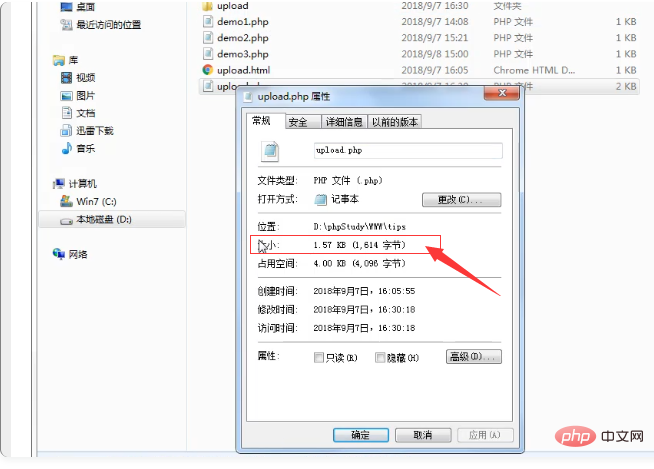Home >Backend Development >PHP Problem >php get file size
For those new to PHP, it may be difficult to implement the function of getting the file size in PHP. However, I believe that novices will be able to easily master the important knowledge of obtaining file size with PHP after reading the introduction in this article!

# Below we use specific code examples to provide you with a detailed analysis of how PHP obtains the file size.
1. First, if you only need to get the number of bytes of the file
You can get it directly through the PHP filesize function. The code is as follows: (Recommended learning: PHP programming from entry to proficiency)
echo filesize("upload.php");Returns the number of bytes of the file size. If an error occurs, it returns FALSE and generates an E_WARNING level error.
Note:
Because PHP’s integer type is a signed integer and many platforms use 32-bit integers, for files above 2GB , some file system functions may return unexpected results.
Access through the browser, the output result is as follows:


2. So if we want to get the file size and display it in a normal size format, how should we do it?
Below we introduce a very simple encapsulation method to obtain the normal size.
The specific code example of the PHP encapsulation method to obtain the normal size is as follows:
<?php
$size = filesize("upload.php");
function trans_byte($byte)
{
$KB = 1024;
$MB = 1024 * $KB;
$GB = 1024 * $MB;
$TB = 1024 * $GB;
if ($byte < $KB) {
return $byte . "B";
} elseif ($byte < $MB) {
return round($byte / $KB, 2) . "KB";
} elseif ($byte < $GB) {
return round($byte / $MB, 2) . "MB";
} elseif ($byte < $TB) {
return round($byte / $GB, 2) . "GB";
} else {
return round($byte / $TB, 2) . "TB";
}
}
echo trans_byte($size);In this code, we first define a $size variable to obtain the size of the upload.php file. section size, and then create a method called filesize. This method is used to convert the byte size into a normal size format.
Everyone should know that computer counting uses binary, which is calculated by powers of 2. 1KB=2 to the 10th power=1024B; 1MB=2 to the 20th power=1024*1024B=1024KB; GB, TB conversion and so on.
So in the filesize method, we first define the four variables $KB, $MB, $GB, and $TB in the above code. Then use if...elseif conditional statements to gradually determine the file byte size, and use the PHP round function to retain two decimal places on the file size value.
Then we test the above encapsulated filesize method to obtain the normal size of the file. Access php through the browser to obtain the file size. The result is as shown below


The above is the detailed content of php get file size. For more information, please follow other related articles on the PHP Chinese website!